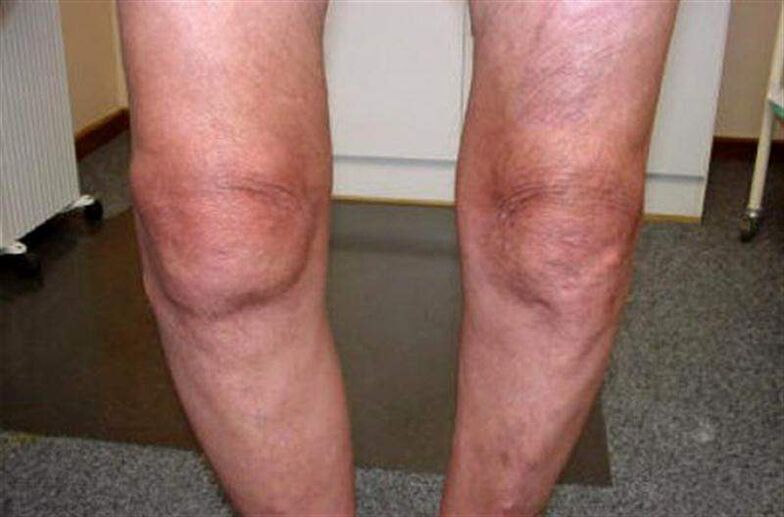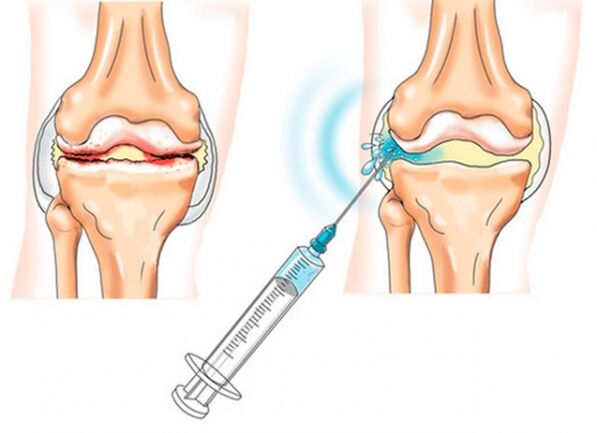
Arthrosis of the knee joint (gonarthrosis) is a disease of the cartilage of the knee in which it gradually dies and is replaced by connective tissue. Knee arthrosis can occur suddenly when there are no signs or causes of joint damage. In other cases, the development of the disease is accompanied by trauma or other joint diseases.
Peculiarities
In a healthy knee joint, cartilage is a type of lining that does not allow bones to come in contact, thus eliminating the possibility of damage while walking. The patient's cartilage is unable to cope with this function, so there are signs of stiffness in the joint during movement, accompanied by pain. This condition persists due to internal pathological lesions, where thinning of the cartilage tissue leads to thickening of the bone and creates the conditions for the appearance of bone spurs - osteophytes - that cause acute pain.
Causes and symptoms
Arthrosis of the knee joint develops gradually, but no pronounced symptoms of cartilage damage are observed, as the knee joint is held in place by the thigh muscles and four ligaments. It is this anatomical structure that smooths out the manifestation of the main symptoms in the early stages of the disease.
Reliable causes of the disease have not yet been identified by medicine. However, there are factors that may play a role in the cause of the disease under certain circumstances. These include injuries, strenuous training and being overweight. As a separate reason, such a violation can be considered a hormonal failure.
If knee arthrosis is suspected, the following symptoms may occur:
- painful knee pain (possibly in the leg);
- weather-related pain syndrome;
- increase in pain when walking up stairs, after long walks or standing;
- reduction of pain at rest (at night and at rest);
- initial pains (after rest breaks);
- stiffness of the knee joint;
- pain when bending / stretching the leg;
- cracking, joint swelling.
This condition of the knee joint requires urgent medical attention because of the risk of complications when fluid buildup can accumulate in the joint. The doctor performs an external examination of the patient and prescribes an examination based on the results of which the treatment methods are selected.
Survey
The initial stages of the occurrence of such a pathology, such as arthrosis of the knee joint, do not manifest visually in any way. However, after a period of time, the patient notices signs of knee deformity as well as characteristic curvature along the axis of the lower leg (directed inward). There is also a crack when you need to bend your legs.

The presence of pain, limited movement of the knee causes a person to see a doctor and undergo an examination. To do this, you must pass the tests and take an x-ray of the patient's joint. If these measures are not sufficient to confirm knee arthrosis, magnetic resonance imaging is performed. Based on the data collected, the doctor will select the best treatment methods.
Treatment methods
Modern medicine has enough tools to treat osteoarthritis of the knee joint. New approaches to treatment with traditional methods are also being developed and actively applied in clinical practice.
The basic medical treatment of knee disease is therapies combined with adjuvants.
An example is kinesiotherapy, which is part of the physiotherapy of restorative medicine, complemented by psychological work with patients.
Help in the treatment of knee inflammation with recovery methods such as massage, exercise, water treatments. To alleviate the condition, it is recommended that the patient wear a knee pad or bandage. Gonarthrosis cannot be treated without a proper diet that includes white, non-red meat, sardines, salmon, vegetables, fruits, and enough water (up to 7 glasses).
Severe cases of the disease are treated immediately with a full or partial prosthesis using gentle methods.

Medical treatment
The following are actively used in the pharmacological treatment of gonarthrosis:
- Non-steroidal anti-inflammatory drugs. The prescribed tablets help to treat conditions such as swelling and swelling of the knee joint;
- Chondoprotectors. The compositions contain substances that nourish the cartilage tissue, which heals its structure and restores the cartilage coating of the joint. If the cartilage is almost completely destroyed, chondroprotectors are not used to treat knee arthrosis (usually stage 3);
- Vasodilator pills. They can help you treat the nocturnal pain that occurs in the knee joint due to cramps in the small blood vessels.
- Intra-articular injections of corticosteroid hormones are prescribed to treat inflamed knee joints. Injections relieve swelling and swelling much faster, thereby improving the patient's condition. However, such injections can be given once every 2 weeks because of the high probability of side effects. If a person has symptoms of anatomical changes in the joints, such as bone deformity, it makes no sense to inject into the joint.
In the initial stage of gonarthrosis, which is not complicated by joint edema (synovitis), the patient may be given injections of chondroprotector with enzymes. They help in the partial recovery of cartilage tissue, and the disadvantage is that 5 to 10 injections have to be given.

Good results of the treatment (in 80% of cases) can be achieved by traction (knee extension).
This is done with a special device or manual therapy. Such traction increases the distance between the bones, resulting in a reduction in joint load and restored performance.
Ointments
Various types of ointments and gels, which are mainly made of natural ingredients, are used in drug therapy for the treatment of joints. Ointments are available without a prescription at pharmacies, but it is safe to consult your doctor. You should also know that the ointment does not cure knee disease but only complements the main treatment.
An ointment based on NVPS (non-steroidal anti-inflammatory drugs) is effective in relieving arthritis.
Warming ointments containing capsaicin are used to improve blood circulation.
Ointments containing salicylic acid are used to treat knee inflammation.
Ointments - chondroprotectors are used successfully in the initial stages of treating a disease to repair damaged cartilage. In order for the active ingredients of the ointment to penetrate better into the focus of inflammation, they should be used in combination with a physiotherapy procedure - phonophoresis.
Support measures
Massage
In the complex treatment of arthrosis of the knee joints, therapeutic massage is actively used, which contributes to the normalization of blood circulation in the injured joint and restores its functions. The massage not only heals, but also awakens the body's defenses, which allows the joint apparatus to quickly restore its effectiveness.
In case of arthritis, knee massage and general healing massage are usually used. Doctors recommend combining general massage with segmental knee massage for greater effect.
Because the massage has a positive effect on muscle tone, the patient’s muscle strength increases and the performance lost by the knee joints is restored. The therapeutic massage begins with a caress and is then rubbed to improve the mobility of the joints. Then comes the stretching. The massage ends with a beneficial vibration for the muscles (not intense). All of these techniques are included in the massage to reduce pain and restore knee freedom of movement.

Knee pads and braces
To reduce the strain on the knee joint and the muscles, ligaments and tendons, it is recommended that patients be placed on a bandage. The knee ligament helps to evenly distribute the pressure on the joint device, thereby stimulating the regeneration of damaged tissues.
Because the bandage is a product, the range of these products is distinguished by a wide variety of colors and corporate styles. The bandage is also available in metal, ceramic, plastic, etc. All of these properties are secondary. The point is that you only need to buy a knee pad or bandage after consulting your doctor.
Knee pads used for wear shall be selected for their intended use. The bandage required in the postoperative period should be carefully sized. Such a knee pad is a rigid bandage.
Under the knee pads, it is better to wear underwear made of cotton fabric or other natural material. Dog hair knee pads have a pronounced healing effect, warming the joint and relieving inflammation.
The most popular type is a spiral-reinforced neoprene bandage that secures joints and muscles. Orthopedic bandages are often used as protection during sports.
You should choose an open or closed knee pad based on the nature of the pain. In case of severe pain, the knee pads should have stiffeners and completely cover the joint. In case of mild pain, open knee pads should be worn.
A novelty is a knee pad made of elastane or polyester. This bond lasts a long time and is easy to care for.
Conclusion
A distinctive feature of modern approaches to the treatment of knee arthrosis is the combination of traditional methods and techniques based on a new generation of drugs and advanced surgical methods. Among the new generation drugs, biostimulants, chondroprotectors and joint fluid protectors are widely used. Forms of knee arthrosis that are difficult to treat conservatively can now be surgically treated with low invasiveness, i. e. , arthroplasty, arthroscopy, and endoprosthesis.



















